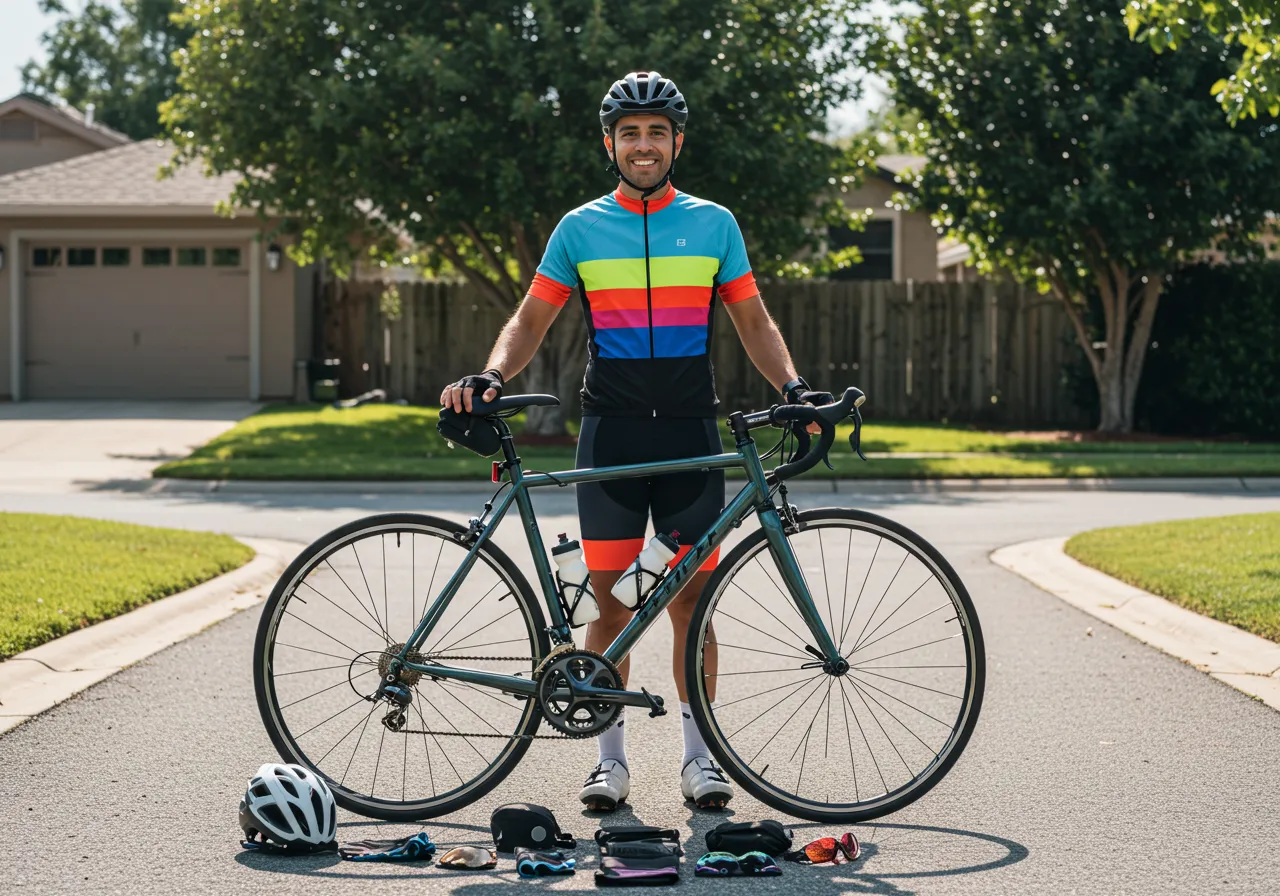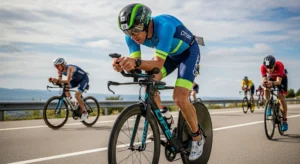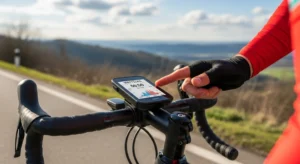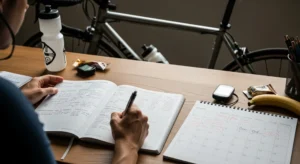Starting your cycling journey means more than just owning a bike. The right gear transforms every ride, keeping you safe, comfortable, and ready for anything. This guide covers the Top 10 Essential Cycling Accessories for Beginners—must-have items that support safety, hydration, convenience, and readiness for unexpected situations.
Here’s what every beginner needs:
- Helmet
- Lights
- Lock
- Gloves
- Water Bottle and Cage
- Pump
- Repair Kit
- Cycling Apparel
- Sunglasses
- Storage Solutions
Each accessory plays a key role in making cycling accessible and enjoyable for new riders. Let’s break down why these items matter and how to choose them wisely.
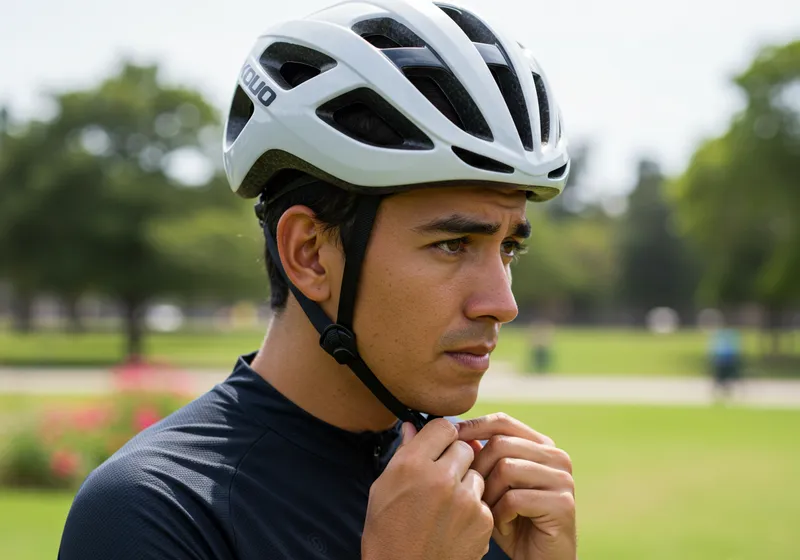
1. Helmet
A cycling helmet is arguably the most crucial accessory for any cyclist, especially beginners. It provides essential head protection in case of falls or accidents, significantly reducing the risk of serious injury.
Importance of Wearing a Helmet for Safety
- Helmets are designed to absorb impact and protect your head during crashes.
- They can prevent head injuries that could be life-threatening or lead to long-term damage.
Types of Helmets Suitable for Beginners
- Road Helmets: Lightweight and aerodynamic, ideal for road cycling.
- Mountain Bike Helmets: Offer more coverage and protection at the back of the head and sides, suitable for off-road trails.
- Commuter Helmets: Often feature built-in lights and reflective elements, perfect for urban cycling.
Features to Look for in a Quality Helmet
- Proper Fit: Ensure the helmet fits snugly without being too tight. Adjustable straps and retention systems help achieve a secure fit.
- Ventilation: Good airflow keeps you cool during rides. Look for helmets with ample vents.
- Safety Certifications: Verify that the helmet meets safety standards like CPSC, EN 1078, or ASTM F1447.
- Comfort: Padding inside the helmet enhances comfort and reduces pressure points.
Investing in a high-quality helmet is a smart decision that prioritizes your safety on every ride.
2. Lights
Enhancing visibility during low-light conditions is crucial for your safety and the safety of others on the road. Front and rear lights make you more visible to motorists and other cyclists, reducing the risk of accidents.
Benefits of Front and Rear Lights
- Front Lights: Illuminate your path ahead, helping you navigate in darkness or poor weather conditions.
- Rear Lights: Make you visible from behind, alerting drivers to your presence.
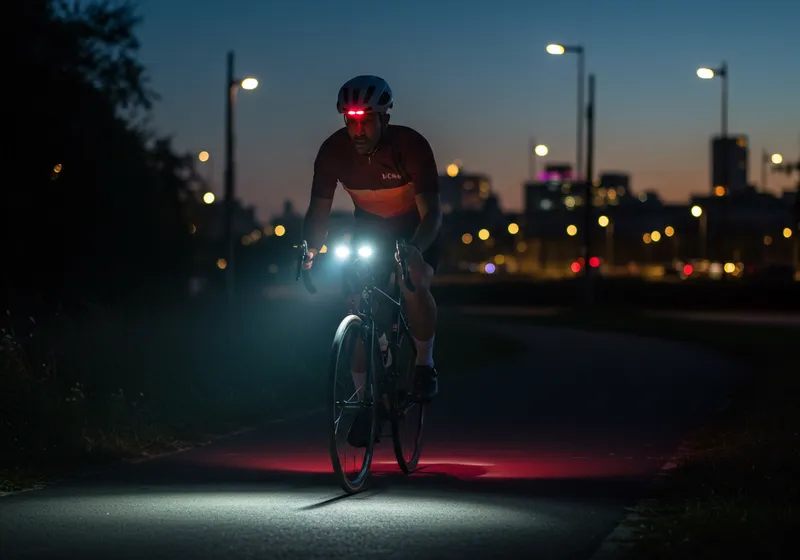
Choosing the Right Lights for Different Riding Conditions
When selecting lights for cycling, consider:
- Brightness: Measured in lumens, higher brightness is essential for night riding, while lower lumens may suffice for daylight visibility.
- Battery Life: Ensure the lights have sufficient battery life for your typical ride durations.
- Mounting Options: Look for lights that are easy to attach and remove from your bike.
Investing in quality front and rear lights enhances your visibility and safety while cycling, especially during low-light conditions.
3. Lock
Securing your bike in public places is crucial to preventing theft. As a beginner, investing in a reliable bike lock is essential for peace of mind. There are several types of locks available:
- U-locks: These are highly secure and resistant to cutting tools.
- Chain locks: Offer flexibility and good security, but can be heavy.
- Cable locks: Lightweight and flexible, but less secure than U-locks or chain locks.
- Folding locks: Compact and easy to carry, providing moderate security.
When choosing a lock, consider the level of security you need and the weight you’re willing to carry.
Tips for proper bike locking techniques:
- Always lock your frame and at least one wheel to a sturdy, immovable object.
- Position the lock as high off the ground as possible to make it difficult for thieves to leverage tools.
- Fill the lock shackle with as much bike frame as possible to limit the room for tools.
- Use additional locks or secure quick-release components like wheels and seats separately.
Investing in a quality lock and using it correctly enhances your bike’s security significantly.
4. Gloves
Cycling gloves are one accessory that beginners often underestimate until they experience their first long ride or encounter rough terrain. These gloves provide a reliable grip on the handlebars, even when your hands get sweaty or the weather turns wet. Better grip means more control and less risk of accidental slips.
Hand protection plays another crucial role. Gloves cushion your palms against road vibrations and pressure from the handlebars, helping to prevent blisters, numbness, and fatigue during longer rides. Many cycling gloves feature padded sections specifically designed to absorb shock on bumpy surfaces.
Choosing the right pair depends on your riding conditions:
- Fingerless gloves excel in warm weather and road cycling, offering ventilation and dexterity.
- Full-finger gloves are suitable for mountain biking or cooler temperatures, providing extra protection against branches and abrasions.
- Look for moisture-wicking fabrics for summer use, and insulated versions if you plan to ride in colder months.
Selecting gloves tailored to your needs ensures every ride is more comfortable and safer, regardless of distance or terrain.
5. Water Bottle and Cage
Staying hydrated during rides is crucial for maintaining energy levels and overall performance. Dehydration can quickly lead to fatigue, making it essential to have a good water bottle and cage setup.
Mounting a Water Bottle Cage
- A water bottle cage is typically mounted on the bike frame, usually within reach while riding.
- Look for cages made of lightweight materials like aluminum or carbon fiber for durability without adding extra weight.
- Ensure the cage fits securely to prevent the bottle from bouncing out on rough terrain.
Choosing the Right Water Bottle
- Opt for a water bottle that fits snugly in your chosen cage.
- Consider bottles with easy-to-use nozzles that allow you to drink without stopping.
- Insulated bottles can be beneficial for keeping liquids cool during longer rides in hot weather.
Investing in a quality water bottle and cage ensures you stay hydrated, enhancing your cycling experience.
6. Pump
A portable pump is an essential tool for every cyclist, especially beginners. It allows you to inflate tires on the go in case of flats, ensuring you’re never stranded mid-ride.
Types of Portable Pumps Suitable for Beginners
- Mini Pumps: Compact and lightweight, mini pumps are easy to carry and can fit in a jersey pocket or a small bag.
- Frame Pumps: Slightly larger than mini pumps, these can be mounted on your bike frame, offering more efficient pumping power.
- CO2 Inflators: Utilize CO2 cartridges for quick inflation. They are faster but require carrying extra cartridges.
Proper Tire Inflation Techniques
- Check Tire Pressure Regularly: Use a pressure gauge to ensure tires are inflated to the recommended PSI.
- Attach Pump Securely: Make sure the pump head is firmly attached to the valve to prevent air leaks.
- Pump Steadily: Inflate the tire with steady, even strokes, until it reaches the desired pressure.
Investing in a reliable portable pump is crucial for maintaining optimal tire pressure and ensuring a smooth riding experience.
7. Repair Kit
A reliable repair kit is your lifeline when unexpected issues arise mid-ride. Carrying a compact set of basic tools and puncture repair patches means you’re prepared for most minor mechanical problems and flats.
Essential items to include in a basic repair kit:
- Tire levers for removing tires quickly
- Multi-tool with Allen keys, screwdrivers, and a chain tool
- Puncture repair patches or a spare inner tube to fix flats fast
- CO₂ inflator or mini pump (if not already carried separately)
- A small adjustable wrench if your bike has non-standard bolts
Punctures are the most common roadside issue. A small patch kit with self-adhesive patches or traditional glue-on patches lets you fix inner tubes without replacing them.
Keep everything organized in a saddle bag or tool canister. This setup ensures you can handle flat tires, loose bolts, or other simple fixes, making every ride less stressful and more enjoyable.
8. Cycling Apparel
Wearing comfortable clothing on the bike makes a noticeable difference from your very first ride. Cycling-specific apparel is designed with features like flat seams to prevent chafing and strategically placed stretch panels that allow for full freedom of movement. Loose-fitting or everyday clothes can snag on the saddle or restrict your pedaling.
Breathable fabric is a game-changer in regulating body temperature. Technical cycling jerseys and shorts use moisture-wicking materials that draw sweat away from your skin, helping you stay cool on hot days and dry when you’re working hard. In cooler weather, layering with thermal or windproof jackets built for cycling keeps you warm without overheating.
When picking out cycling apparel for beginners:
- Start with a good pair of padded shorts for comfort on longer rides.
- Opt for jerseys with rear pockets to stash snacks, keys, or a phone.
- Look for items labeled as “breathable” or “moisture-wicking.”
- Consider lightweight windbreakers or rain jackets if you expect variable weather.
Choosing gear tailored for cyclists means fewer distractions and more comfort, letting you focus fully on enjoying the ride.
9. Sunglasses
Eye protection is crucial for cycling, which is why sunglasses are one of the Top 10 Essential Cycling Accessories for Beginners. When you go on long rides, your eyes are exposed to harmful UV rays that can cause strain and permanent damage over time. That’s why it’s important to wear sunglasses with full UV protection—they not only shield your eyes from the sun but also protect them from wind, dust, insects, and debris kicked up by passing vehicles or riders.
One of the main benefits of wearing sunglasses while cycling is reducing sun glare. This is especially important when riding during dawn, dusk, or in bright midday conditions. High-quality cycling sunglasses are designed to enhance visibility by cutting down glare and improving contrast on the road or trail. As a result, you’ll experience less squinting and fewer distractions—both of which are essential for your comfort and safety.
Understanding Lens Tints
When it comes to lens tints, different options serve different purposes:
- Clear lenses: Ideal for low-light or night riding.
- Yellow/amber lenses: Boost contrast in overcast or shaded environments.
- Dark/gray lenses: Offer strong protection against bright sunlight.
Ensuring a Secure Fit
A secure fit is crucial to ensure that your sunglasses stay in place during bumpy rides. Look for designs that offer adjustable features or rubberized nose pads for added grip. Additionally, wraparound styles provide extra coverage from all angles, making them a smart choice for any beginner cyclist prioritizing eye protection.
10. Storage Solutions
As a beginner cyclist, it’s important to have a way to carry your essentials such as keys, snacks, and phone for convenience and safety. There are various storage options available that can help you organize and transport these items effectively.
Types of Storage Solutions
Here are some different types of storage solutions you can consider:
- Saddle Bags: These bags are attached under the bike seat and are compact, making them perfect for storing small essentials like tools, keys, and money.
- Handlebar Bags: Mounted on the handlebars, these bags offer easy access to items like snacks or a phone while riding.
- Frame Bags: These bags fit within the bike frame triangle, providing additional storage without affecting aerodynamics.
- Panniers: Often attached to rear racks, panniers are ideal for carrying larger items or groceries, making them excellent for commuting.
Organizing Tips
To make the most out of your storage solutions, here are some tips on how to organize your items:
- Use separate compartments within bags to keep items organized.
- Ensure heavier items are balanced to avoid affecting bike handling.
- Opt for waterproof materials to protect contents from weather elements.
Investing in proper storage solutions ensures that your ride is comfortable and you have everything you need at arm’s reach.
Conclusion
Investing in quality gear can significantly enhance your cycling experience, making it both safe and enjoyable. The Top 10 Essential Cycling Accessories for Beginners are designed to address safety, comfort, and convenience. By equipping yourself with these essentials, you will be better prepared for various situations on the road or trail, ensuring a safe cycling experience and more enjoyable rides. Prioritize these accessories to start your cycling journey on the right foot.
